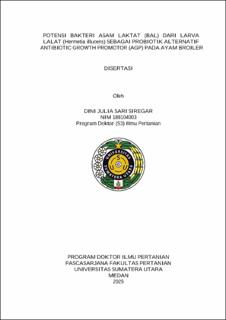Potensi Bakteri Asam Laktat (BAL) Dari Larva Lalat (Hermetia illucens) Sebagai Probiotik Alternatif Antibiotic Growth Promotor (AGP) Pada Ayam Broiler
Potential of Lactic Acid Bacteria (LAB) from Black Soldier Fly (Hermetia illucens) Larvae as Probiotic Alternatives to Antibiotic Growth Promoters (AGPs) in Broiler Chickens

Date
2025Author
Siregar, Dini Julia Sari
Advisor(s)
Julianti, Elisa
Tafsin, Ma'ruf
Suryanto, Dwi
Metadata
Show full item recordAbstract
Antibiotic growth promoters (AGPs) are commonly used in poultry farming to inhibit bacterial gowth and enhance chicken performance. However, AGPs have been banned in Indonesia due to their adverse effects on human health, particularly the development of antibiotic resistance from antibiotic residues in chicken products. This ban has negatively impacted poultry performance and health, necessitating alternative AGP solutions. Lactic Acid Bacteria (LAB) serve as a promising probiotic alternative to AGPs. LAB can be isolated from diverse environments, including water, soil, mud, and they can also adhere to living organisms such as plants, animals, and humans. LAB produce antimicrobial compounds that inhibit pathogenic and spoilage bacteria. The larvae of the Black Soldier Fly (Hermetia illucens) / BSF larvae have shown potential as a source of LAB, making them a viable candidate for probiotic development. The study comprises three phases: (1) Production of BSF larvae on different gowth media and characterization of LAB isolates. (2) Evaluation of LAB isolates from BSF larvae as probiotic candidates. (3) Assessment of performance, digestibility, and physiology of broiler chickens supplemented with potential probiotics from BSF larvae during Salmonella enterica serovar. Pullorum infection. Experiments were conducted in the Laboratory of Medicine, Faculty of Medicine, Universitas Sumatera Utara and in the Laboratory of Fundamental Sciences, Universitas Pembangunan Panca Budi from October 2021 to February 2022. The results of Phase I of the study reveal that after 18 days, the highest fresh weight and biomass of BSF larvae were achieved in treatment P2, which combined fruit-vegetable waste (2 kg) with tofu waste (1 kg). Conversely, treatment treatment P1, which utilized a gowth medium composed of chicken manure (2 kg) and tofu waste (1 kg), exhibited the highest crude protein content. Treatment P3, consisting of empty palm oil bunches (2 kg) and tofu waste (1 kg), demonstrated the lowest productivity for BSF larvae. The number of LAB isolates varied among treatments, with treatment P2 producing the highest number of isolates (19), while treatments P1 and P3 each yielded 9 isolates. Physiological characterization indicated that the majority of LAB isolates were Gram-positive, rod shaped, catalase-negative, and homofermentative. The isolates collected during this phase will proceed to Phase II of the research, where their probiotic potential will be evaluated for application in broiler chickens. The results of Phase II revealed that 13 LAB isolates displayed antagonistic (antibacterial) activity against Escherichia coli, Salmonella enterica serovar Pullorum, and Salmonella enterica serovar Typhimurium. Molecular identification based on the 16S rRNA gene indicated that LAB isolates from BSF larvae belonged to three species: Lacticaseibacillus paracasei, Lactiplantibacillus pentosus, and Lactiplantibacillus plantarum. Tolerance tests of LAB isolates to bile salt concentrations of 0.1% and 0.3% showed variations in viability at the 90th hour, with isolates 5P1i1 and 6P2i2 having the highest final density. Tolerance tests ofLAB isolates to pH levels of 2, 3, 6, and 7 also demonstrated variations in viability at the 90th hour, with isolate 5P2i5 exhibiting the highest final density at pH 3. The best adhesion ability to the chicken ileum was demonstrated by isolate 5P2i9. Based on multivariate analysis or PCA, three LAB isolates were selected as probiotic candidates for in vivo testing in broiler chickens: L. pentosus 5P2i1, L. paracasei 5P2i5, and L. pentosus 5P2i9. From the Phase II selection results, three main candidates were identified for further in vivo testing in broiler chickens: L. pentosus 5P2i1, L. paracasei 5P2i5, and L. iii pentosus 5P2i9. The Phase III study employs a completely randomized non- factorial design with seven treatments and three replicates, involving 105 broiler chickens (five per plot). The treatments are categorized into control goups (R0a: healthy chickens, R0b: infected chickens with Salmonella pullorum) and treatment goups (R1: infected + virginiamycin antibiotic, R2: infected + colistin antibiotic, R3: infected + probiotic L. paracasei 5P2i5, R4: infected + probiotic L. pentosus 5P2i1, R5: infected + probiotic L. pentosus 5P2i9). Observed parameters include gowth performance and feed digestibility, live weight, carcass weight, fat deposits, hematological and blood lipid profiles, intestinal morphology, immune organ weights, and gut microbiota dynamics. The results from Phase III demonstrate that both antibiotic and probiotic treatments, particularly L. paracasei 5P2i5, have similarly positive effects across all observed parameters. These findings suggest that the identified probiotics can be further developed as antibiotic alternatives to enhance poultry health and growth.
